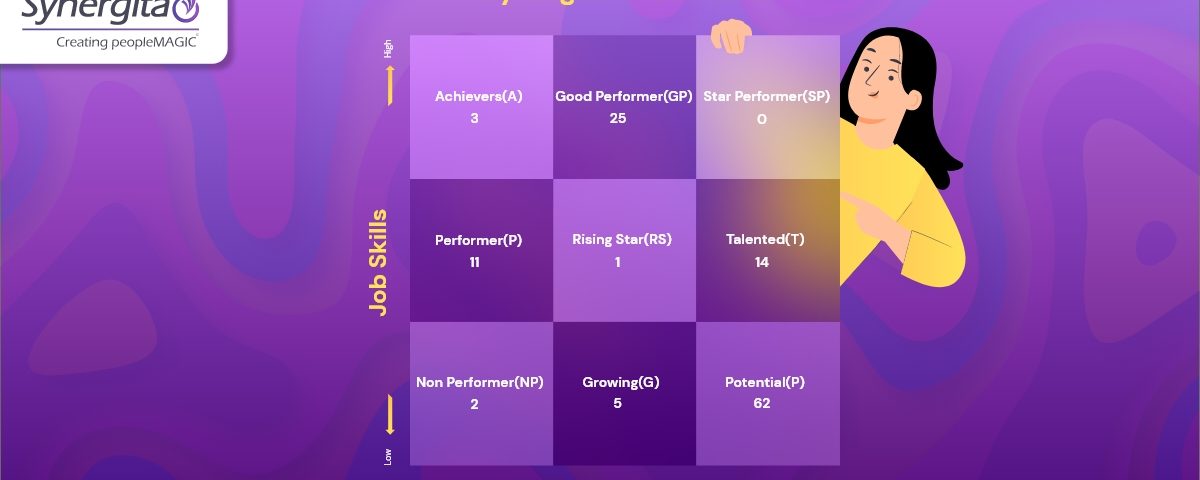When evaluating an employee’s performance, managers usually focus on two things. Firstly, how well are they performing right now and secondly, how well are they expected to perform in the future (i.e., their growth potential)?
For managers looking to create a solid succession plan, establishing a process for assessing employee performance is imperative. Since each role requires a unique set of skills, the metrics used to evaluate employee performance will ultimately depend on the type of business.
The Synergita 9-box grid is a well-known employee management tool where employees are classified into nine categories to assess their performance and potential.
How does the Synergita 9-box grid assess employee performance?
The Synergita 9-box grid provides a framework for managing all the employees in an organisation. This grid is used to assess an organisation’s existing talent to identify potential leaders and employees that may need help.
When Goals (Y-Axis) and Competencies (X-Axis) are evaluated and plotted on the graph, those in the upper right quadrant are identified as high-potential candidates for succession, whilst those in the lower left quadrant may need to be transferred or removed from the organisation.

For instance, in a Synergita 9-box grid report, good or star performers in the top right quadrants are considered great team members and have the potential to shine. On the other hand, non-performers who fall in the bottom left quadrant will need a lot of managerial support and are unlikely to improve.
However, just because an employee may be matched to a non-performer box does not imply they should automatically be fired from the organisation. The current position of an employee affects both their potential and performance. Everyone flourishes in different environments. So knowing where each of your employees falls in the 9-box will help you determine whether another position in your organisation may be a better fit for them.

Top benefits of the Synergita 9-box grid for business leaders and HR managers
The Synergita 9-box grid comes with an easy-to-understand structure for business leaders and HR managers. Even if they are unfamiliar with this tool, the grid’s visual representation makes it simple to grasp. It provides many other benefits, as listed below:
Builds a holistic Talent Evaluation Tool
The Synergita 9-box grid helps you undertake a more thorough approach to employee performance management. You can evaluate current performance and potential for the future without getting caught up in just one or two aspects of an employee’s performance.
Enhances talent versatility
Using the Synergita 9-box grid gives a clear picture of employees’ potential and the roles they might thrive in the future. In other words, it makes succession planning simpler. You can also find employees who have the potential to be leaders and transfer them into management career paths.
Discovers valuable talent
With the Synergita 9-box grid, you can spot high potential performers inside your organisation and determine what they need to work on to grow. You will have the information you need to support your decision of where and how to focus your efforts to engage and advance these employees. Additionally, you will be able to target suitable candidates for internal promotions as they arise.
Improves company culture
The Synergita 9-box grid gives management a snapshot of an employee’s performance and potential, allowing them to assess human talent and decide how to employ it. Each employee may bring an exceptional talent or level of expertise that can benefit the company and enhance the workplace culture. Through the 9-box grid, a process is put in place to ensure that this happens.
Maps employee development
The Synergita 9-box grid becomes crucial to create the right development program for employees based on their personalised needs. It creates a mechanism to continuously understand which category an employee falls into so that HR and managers can help them achieve their career goals.
How the Synergita 9-box grid helps effective development and planning talent identification
Once employees have been divided into the nine categories, customised development plans can be created for each employee. On the matrix, investment in employee development plans should increase as you go farther right and upward and decrease as you move further left and downward. In general, it is best to invest the most time, effort, and resources in top performers with high potential and the least in poor performers with low potential.
Business leaders and HR managers can also use information from the Synergita 9-box grid to identify talent within the organisation. After identifying important roles that need to be filled, employees can start getting assessed using the 9-box grid to fill these positions.
To create a strong succession plan, employees should be evaluated at varying stages of their career paths, as this will help to identify high performers who have the potential to rise in the ranks.
By identifying talent within the organisation and developing customised development plans, businesses can enhance employee positioning, promote employee development, boost productivity and enhance overall ROI.
Want to unlock your employees’ true potential but unsure where to start?
Synergita’s continuous performance management software (PMS) is a perfect blend of continuous feedback processes and traditional appraisal sessions. End-to-end automation streamlines the performance appraisal process, including goal-setting and disseminating appraisal letters.
Synergita’s visual dashboard also provides a concise summary of your employees, performance status, and action items. With the help of the PMS, you can make data-supported HR decisions that can improve employee engagement and performance.
To know more, check our products and sign up for a free trial and see how we unlock your organisation’s true potential.
